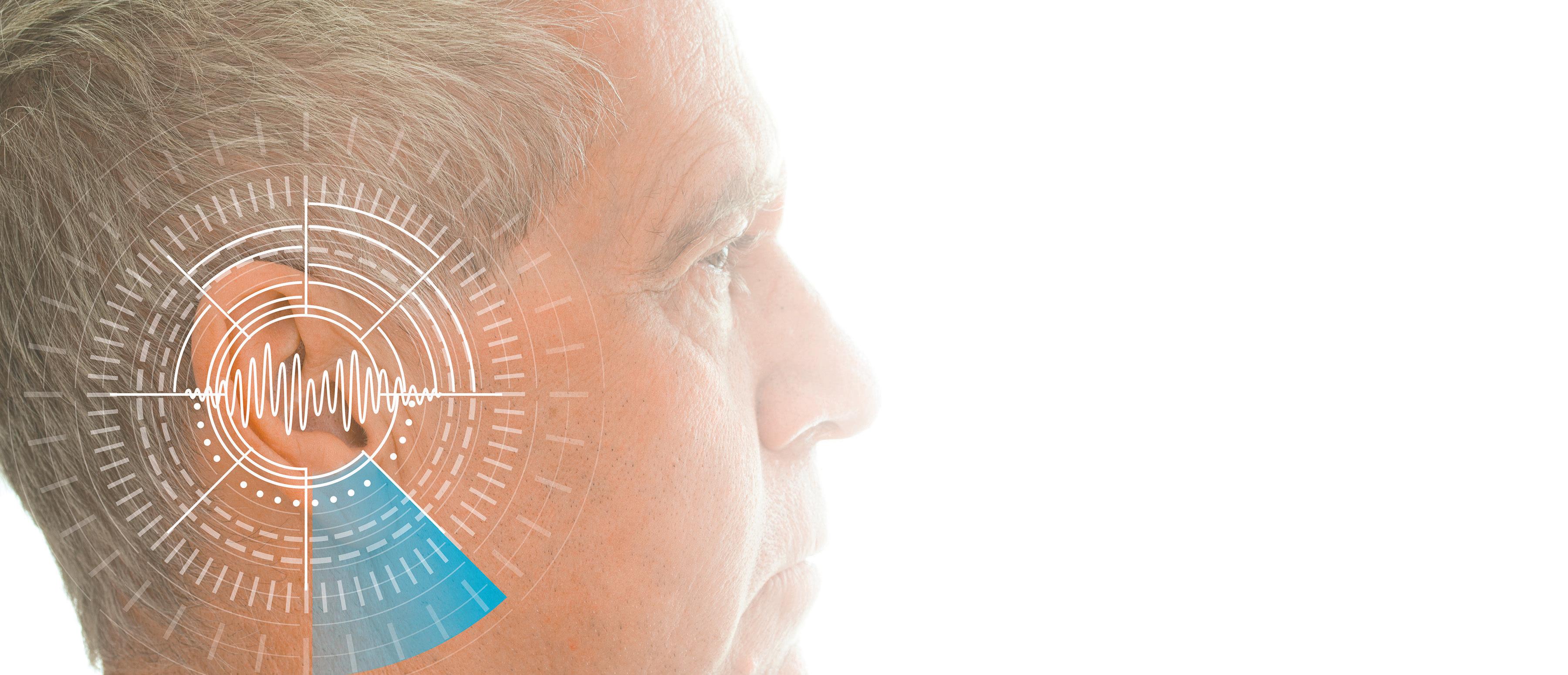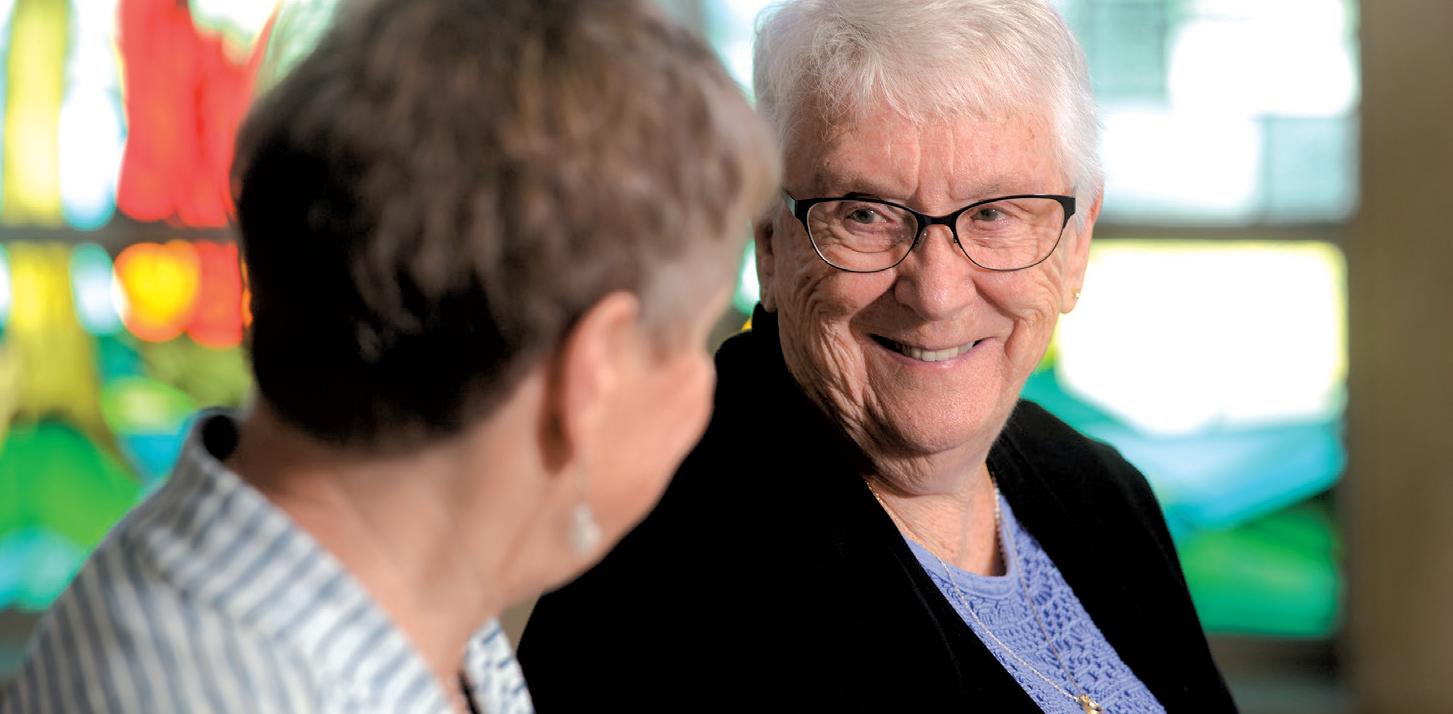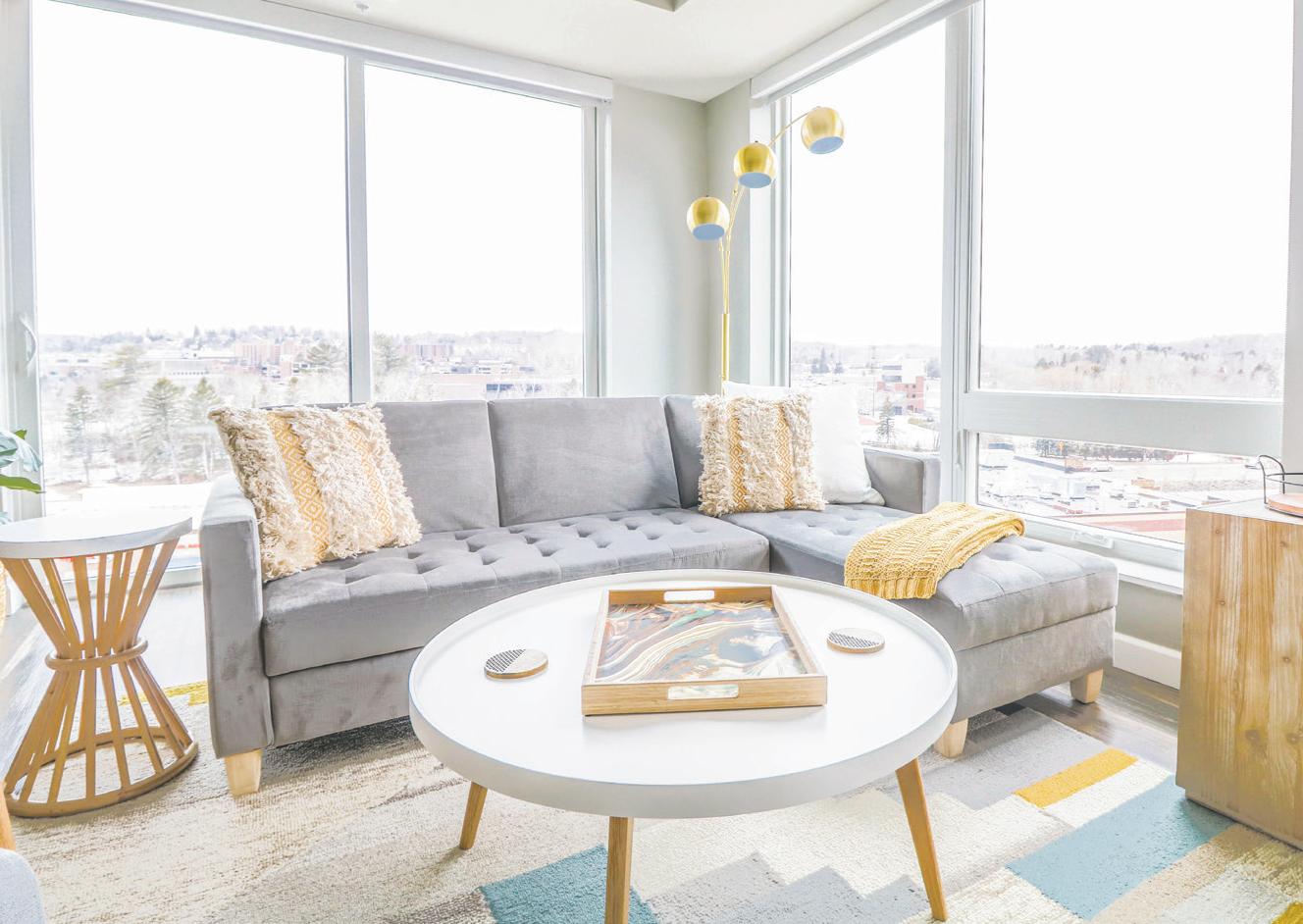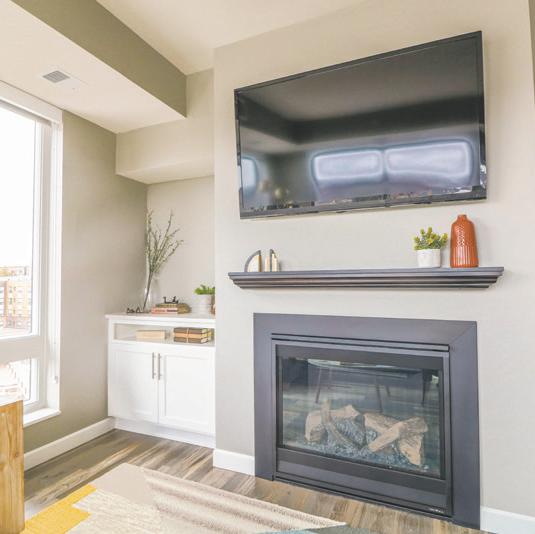By Andrea Busche page 2




 By Abigail Blonigen page 4
By Abigail Blonigen page 4
Generations APRIL 2021 A SPECIAL SUPPLEMENT TO Don’t Miss! • Service Directory, page 10 • Sudoku and Word Find, page 11 • Recipe, page 11 Preserve your Vision!
Better Hearing!
By Andrea Busche
From beautiful spring flowers and good books to precious grandchildren and silly pets, there are so many beautiful things in the world. The ability to see is a gift to be treasured and preserved at all costs.
In honor of Healthy Vision Month in May, we picked up some eye care tips from optician Kat Leek, owner/operator of Kat’s Eyes Optical at 1016 Woodland Avenue in Duluth. She specializes in analyzing prescriptions and helping clients select the right lenses and frames to best suit their needs.
PRESERVING HEALTHY VISION


Leek’s top tip is to receive regular eye examinations.
“People should get their eyes examined by an optometrist or ophthalmologist yearly,” she said. “This has to do with the health of their eyes,
and is separate from getting an eyeglass prescription.”
Another important suggestion is to protect your eyes from the sun’s powerful rays.
“For people who are outside all day, they should be wearing sunglasses with optical-quality, polarized lenses to protect their eyes,” Leek said.
If you wear glasses, it is important to ask your eye care professional about getting the right lens material and style for your needs. Some options include polycarbonate lenses, plastic lenses, bifocals and trifocals.


“For those who are looking at a computer all day, or doing mid-range work, everyone from quilters to anesthesiologists should ask about task-specific eyewear,” Leek said. A skilled optician can help you find your perfect match, based on your unique prescription and lifestyle.
GLASSES: PAGE 3
2 | WEDNESDAY, APRIL 28, 2021 GENERATIONS
Tips to preserve your vision and protect your glasses
Link to an expert by phone or online! 1-800-333-2433 www.MinnesotaHelp.info® A service of the Minnesota Board on Aging and Arrowhead Area Agency on Aging •Prescription Drug Assistance •Medicare & Health Insurance Issues •Housing •Long-Term Care Options •Caregiver Support •Food/Meal Delivery •Transportation •Volunteer Opportunities •Much More YOUR CONNECTION TO: 001717978r1 Senior LinkAge Line® is a service of the Minnesota Board on Aging and Arrowhead Area Agency on Aging Mn.gov/senior-linkage-line Senior LinkAge Line 800-333-2433 Link to an expert by phone or online! From independent living to assisted living and memory care, we provide a sense of comfort, security and independence where seniors can age in community Call today for a tour. (218) 522-8899 BLCDuluth.org A place to call home EEO/AA/Vet Friendly
Another item to be aware of is the fact that items lit by LEDs, such as laptops, flat screen TVs and cell phones, give off UVC rays. Your optician can add a special coating or tint to your glasses to help protect your eyes from these rays.
PROTECTING YOUR GLASSES
If you wear glasses, or even the occasional “cheaters” (reading glasses), Leek offered several unique tips for keeping them clean and well-aligned.
“Rather than using harsh chemicals, soap and water mixtures clean your glasses better than any product you can buy,” Leek said. “You can use a little dishwashing soap or liquid hand soap. Rinse well, and then dry them with a soft towel or microfiber cloth.”
Leek also recommends visiting your optician every six months, just to check in. Your optician can make minor tweaks to the frames and/ or lenses to ensure your glasses still fit properly.
The next couple tips may
sound like good old-fashioned common sense, but many of us don’t do them. For instance:
When you are in or around water, your glasses should be secured around your neck with a cord so they don’t end up at the bottom of a lake.
When your glasses aren’t on your face, put them in their case. Remember this little rhyme to ensure you don’t sit on them, and they won’t be chewed and destroyed by a pet. Always use two hands to remove your glasses. This helps keep them in alignment.
PREVENTION IS KEY
Even if your eyesight is good, there are things we all can do to preserve healthy vision. Preventative measures such as regular eye exams and protecting your eyes from the sun are simple things that can pay dividends well into the future. And, if you wear glasses, minor adjustments to your daily routine can keep them in tip-top shape.
Consider these optician-recommended ideas to enjoy the gift of sight for many years to come.


GENERATIONS WEDNESDAY, APRIL 28, 2021 | 3 Better hearing means mom’s as sharp and witty as ever! Wh at wi ll better hearin gd ofor yo u? •Hearing Evaluation •TinnitusTreatment •Hearing AidFittings •On-Site Repair Lab •Hearing Protection •Cerumen Removal www.h ea rwel ln or th .com Hearing Wellness Center Tinnitus TreatmentCenter Duluth |Cloquet |Superior Services Provided: Letushelpyou Hear Well™
Andrea Busche is a Duluth freelance writer.
GLASSES: FROM PAGE 2
HEARING FROM THE EXPERT Tips for preventing and detecting hearing loss
By Abigail Blonigen
“Hearing is something that people often don't think about because it's invisible,” said Dr. Jonathan Gervais, audiologist at Hearing Wellness Center.
The need for awareness around hearing issues is why May is Better Hearing Month. According to the National Institute on Deafness and Other Communication Disorders, one in eight people above the age
of 12 has hearing loss in one or both ears.
Age is a significant factor in hearing loss, with only 2% of adults aged 45 to 54 having disabling hearing loss as compared to 25% of those aged 65 to 74 and 50% of those 75 and older.

Because of this, Gervais recommends adults receive a baseline hearing exam by the age of 40. This helps patients
and providers catch and treat signs of hearing loss early on.

Proper treatment for hearing loss not only improves day to day life and social function for the individual, but it may help ward off memory loss as well.
“Hearing loss and memory are very strongly linked to each
other,” Gervais said, referring to a Johns Hopkins study that revealed mild hearing loss as doubling one’s risk for dementia.
Hearing aids are the primary treatment for hearing loss, however there are also online listening programs that can
4 | WEDNESDAY, APRIL 28, 2021 GENERATIONS St. Croix Hospice. Care you can trust.
make house calls—bringing
to you
home
ff
experienced,
clinical
24/7
and holidays
stcroixhospice.com
• We
care
wherever you call
• We o
er
compassionate local
care teams • We are available
including nights, weekends
® 855-278-2764
HEARING: PAGE 5
help train the brain to listen, focus, and communicate better. Gervais said these programs are best suited for those who may not need hearing aids quite yet or as a treatment in conjunction with hearing aids.

Early signs of hearing loss may include misunderstanding conversations, repeatedly asking people to repeat themselves, always thinking people are mumbling, having a hard time hearing in noisy environments like restaurants, or having a frequent buzzing or ringing in the ear(s).
While hearing loss can be genetic, it can also have environmental causes. Gervais recommends veterans, people who work in loud environments, and those who listen to loud music or frequented loud concerts in their youth to get their ears checked out.
In terms of prevention, Gervais said, “Treat your ears like
they’re gold.”
While doing anything noisy, such as snowblowing, lawn mowing or even vacuuming, Gervais recommends wearing ear plugs or ear muffs to protect the ears from the sound.
“It’s not just necessarily how loud the noise is but, it’s also how long you’re around it,” he said. “If you’re mowing your lawn once a week for 20 minutes each time, the damage starts to add up over time.”
Gervais, who has dealt with hearing loss from a fairly young age and wears hearing aids himself, encourages folks to find a provider they are comfortable with and ensure that their hearing aids are properly fitted.
Family and friends generally notice hearing loss in a loved one before they do, so if the people in your life are voicing their concerns, it never hurts to get it checked out.

Blonigen is a Duluth freelance writer.
What is diabetic eye disease?

The term “diabetic eye disease” refers to a group of eye conditions, such as diabetic retinopathy and diabetic macular edema, that can affect people with diabetes. The National Eye Institute notes that all forms of diabetic eye disease can potentially cause severe vision loss and even blindness. However, the NEI says vision loss can be prevented or delayed if diabetes patients take their medications as prescribed, stay physically active and eat a healthy diet. Seeking timely treatment by consulting a physician the moment they notice changes in their vision, however insignificant those changes may seem, is another way for diabetes patients to protect themselves against vision loss. It’s especially important that diabetes patients heed that advice,
as the NEI notes that vision lost to diabetic eye disease is sometimes irreversible. It’s also important that diabetes patients know that help could be on the way, as the NEI is conducting and supporting research to find better ways to detect, treat and prevent vision loss in people with diabetes.

GENERATIONS WEDNESDAY, APRIL 28, 2021 | 5 The J.S. Realty team understands your special real estate needs and knows exactly what it takes to get the job done quickly and easily. Let us handle the sale or purchase of your property. Take advantage of the 90 years of combined local experience we can offer. Three Generations Serving YOU Call our office at 218-729-9784 to speak with Jackie, Jamie, Julie or Braxton today!
Abigail
HEARING: FROM PAGE 4
Celebrate!
May 1: New Home Owners Day
May 1: Barbecue Day
May 2-7: Public Service Recognition Week
May 2-8: National Hospital Week
May 2-8: Correctional Officers Week
May 2-8: Nursing Home Week


May 3-7: Teacher Appreciation Week
May 4: International Firefighters Day
May 4: National Teacher Day
May 5: Cinco De Mayo
May 6-12: Nurses Week
May 9: Mother's Day
May 9-15: National Police Week
May 9-15: National Women's Health Week
May 9-15: National Skilled Nursing Care Week
May 16-22: National EMS Emergency Medical Services Week
May 27: Sunscreen Day
May 31: Memorial Day
The various types of glaucoma and their symptoms
Eyesight is important but easily taken for granted. Few people can imagine life without their eyesight, but hundreds of millions of people across the globe experience compromised vision every year.
According to the Centers for Disease Control and Prevention, glaucoma is the second leading cause of blindness worldwide. In fact, estimates from the World Glaucoma Association indicated that 79.6 million individuals would experience glaucoma in 2020. By 2040, that figure is expected to rise to 111.8 million people.
WHAT IS GLAUCOMA?
Glaucoma is a disease that damages the optic nerve. According to the American Academy of Ophthalmology, glaucoma usually results from the buildup of fluid in the front part of the eye. As that fluid builds up, it increases the pressure in the eye, ultimately damaging the optic nerve.
ARE ALL GLAUCOMAS THE SAME?
All glaucomas are not the same, and the AAO notes that there are two major types of the disease: primary open-angle glaucoma and angle-closure glaucoma.
• Primary open-angle glaucoma: The most common type of the disease, primary open-angle glaucoma develops gradually. Eyes affected by primary open-angle glaucoma do not drain fluid as well as they should, resulting in the buildup of pressure that slowly starts to damage the optic nerve.
• Angle-closure glaucoma: Angle-closure glaucoma occurs when a person’s iris is very close to the drainage angle in his or her eye. The AAO says that this proximity can block the drainage angle, causing pressure to
build up very quickly. However, the AAO also notes that many people with angle-closure glaucoma develop it very slowly and have no idea they have it until they’ve suffered severe damage.
WHAT ARE THE SYMPTOMS OF GLAUCOMA?
The symptoms of glaucoma differ depending on which type a person has.
According to the AAO, there are no obvious symptoms in the early stages of open-angle glaucoma. Blind spots develop in patients’ peripheral vision as the disease progresses. Because people often do not experience symptoms until the damage from open-angle glaucoma has become severe, the AAO urges adults to schedule routine eye exams with an ophthalmologist so the disease can be found before any significant damage has occurred.
Blurred vision, halos, mild headaches, or eye pain are some early symptoms of an angle-closure glaucoma attack. However, the AAO notes that people with angle-closure glaucoma do not typically notice any symptoms until the attack has started. As a result, the AAO urges anyone experiencing any of the aforementioned symptoms to contact their ophthalmologist immediately. Once an angle-closure glaucoma attack has begun, symptoms may include:
• severe pain in the eye or forehead
• redness of the eye
• decreased vision or blurred vision
• nausea
• vomiting
No one is immune to glaucoma, which can quickly rob otherwise healthy individuals of their vision. Learning to recognize the early signs of glaucoma and seeking prompt treatment can reduce the likelihood of substantial vision loss.
6 | WEDNESDAY, APRIL 28, 2021 GENERATIONS • Companionship Care • Personal Care • Meals & Nutrition • Transportation • Household Duties • Respite Care • Hospice Care Support Services Home Instead CAREGivers can provide a variety of services. Some include: Twin Ports: 218-727-8810 • Iron Range: 218-262-6177 www.homeinstead.com/548 Call for a free, no-obligation appointment
Volunteer Drivers Needed

About the Program
What do volunteer drivers do?
Volunteer drivers provide individuals in need of transportation with a means of getting to and from medical appointments.
Who qualifies to be a volunteer driver?
Anyone who is:
• Age 21 or older
• Has a valid driver’s license
• Has proof of insurance
• Has a clean driving record
• Has not had a suspended license or DWI within the past 3 years
• Has had no felony convictions
What type of insurance coverage must a volunteer driver have?


A volunteer driver is required to provide enough insurance to allow them to drive legally in the state of Minnesota.
What type of vehicle can be used?
The vehicle must be safe, dependable and clean. Volunteer drivers use all different types of vehicles from small subcom-pacts to large SUVs.
How can I become a volunteer driver?
Call Transportation Coordinator Scott Olson at (218) 735-6886 or scott.olson@aeoa.org.

FAQs
Q. Do volunteer drivers receive any reimbursement?
A. All volunteer drivers are reimbursed at the maximum federal mileage rate. Mileage is reimbursed from the time the drivers leave their home until they return home.
Q. How are volunteer drivers reimbursed?
A. Volunteer drivers submit mileage reimbursement forms for all rides provided and receive reimbursement by direct deposit.
GENERATIONS WEDNESDAY, APRIL 28, 2021 | 7
UNDERSTANDING EXTENDED CARE
The important question: Are you prepared?
Content provided by Ed Grondahl
Addressing the potential threat of extended care expenses may be one of the biggest financial challenges for individuals who are developing a retirement strategy.
The Administration for Community Living estimates that by 2060, 94.7 million Americans will be aged 65 and older. Of those, it’s estimated that someone who just turned 65 has an almost 70% chance of needing some type of extended care.1,2.
WHAT IS EXTENDED CARE?
Extended care is not a single activity. It refers to a variety of medical and non-medical services needed by those who have a chronic illness or disability that is most commonly associated with aging.
Extended care can include
everything from assistance with activities of daily living, like providing help with dressing, bathing, using the bathroom, or even driving to the store. Extended care may also include more intensive therapeutic and medical care requiring the services of skilled medical personnel.
Extended care may be provided at home, at a community center, in an assisted living facility, or in a skilled nursing home. It’s also important to recognize that extended care is not exclusively for the elderly; it is possible to need extended care at any age.
HOW MUCH DOES EXTENDED CARE COST?
Extended care costs vary state by state and region by region. The national average for
Ed Grondahl

may be reached at 218-336-1825 or Edward.Grondahl@cunamutual.com.
This material was prepared by MarketingPro, Inc., and does not necessarily represent the views of the presenting party, nor their affiliates. This information has been derived from sources believed to be accurate. Please note - investing involves risk, and past performance is no guarantee of future results. The publisher is not engaged in rendering legal, accounting or
extended care can cost anywhere from $50,000 to $100,000 or more a year. The cost for a home health aide starts at an average of $20 per hour, but can be expected to increase if skilled nursing is involved.3
Individuals who would rather not burden their family and friends have two main choices for covering the cost of extended care: they can choose to self-insure or they can purchase extended-care insurance.
Many self-insure by default, simply because they haven’t made other arrangements. Those who self-insure may depend on personal savings and investments to fund any extended care needs. The other approach is to consider purchasing extended care insurance, which can cover all levels of care, from skilled
other professional services. If assistance is needed, the reader is advised to engage the services of a competent professional. This information should not be construed as investment, tax or legal advice and may not be relied on for the purpose of avoiding any Federal tax penalty. This is neither a solicitation nor recommendation to purchase or sell any investment or insurance product or service, and should not be relied upon as such. All indices are unmanaged and are not illustrative of any particular investment.
Securities sold, advisory services offered through CUNA Brokerage Services, Inc.
care to custodial care to inhome assistance.
Several factors will affect the cost and availability of extended-care insurance, including age, health, and the type and amount of insurance purchased. You should consider determining whether you are insurable before implementing a strategy involving extended-care insurance. Any guarantees associated with a policy are dependent on the ability of the issuing company to continue making claim payments.
When it comes to addressing your extended care needs, many look to select a strategy that may help them protect assets, preserve dignity, and maintain independence. If those concepts are important to you, consider your financial approach for extended care.
(CBSI), member FINRA/SIPC, a registered broker/dealer and investment advisor. CBSI is under contract with the financial institution to make securities available to members. Not NCUA/NCUSIF/FDIC insured, May Lose Value, No Financial Institution Guarantee. Not a deposit of any financial institution. CUNA Brokerage Services, Inc., is a registered broker/dealer in all fifty states of the United States of America.
CITATIONS
1. ACL.gov, July 28, 2020
2. ACL.gov, February 18, 2020
3. AARP.org, November 20, 2020
8 | WEDNESDAY, APRIL 28, 2021 GENERATIONS
SPONSORED CONTENT
Hearing aids have a long, rich history

Today’s hearing aids are remarkable devices that help people who are hard of hearing in myriad ways. These devices are part of a rich history of hearing assistance items that dates back several centuries.


According to BeltoneTM, a developer of high-quality hearing solutions that has been in business since 1940, hearing aids can be traced all the way back to 1588, when the author Giovanni Battista first mentioned hearing assistance devices in the book, “Natural Magick.” The devices Battista described were wooden and were carved into the shapes of ears belonging to animals with superior hearing. Whether they worked or not, these rudimentary devices serve as ancestors to the devices people use today.
Many people might recognize the hearing aids used in the 1600s and 1700s. Often referred to as “ear trumpets,” these devices were wide at one end to gather sound and narrow at the other end so amplified sound could be directed into the ear. Perhaps the most notable user of ear trumpets was the great composer Ludwig van Beethoven, whose hearing began to deteriorate by the time he reached his late 20s. By the time of his death in 1827, Beethoven was almost completely deaf. According to the
House Providence Hearing Health Centers, the first person to commercially produce ear trumpets was London-based Frederick C. Rein, who began producing the devices in 1800. In 1819, Rein was commissioned to design a special acoustic chair for John VI, the King of Portugal.
By the early 1900s, electricity would change hearing aids forever. Instead of ear trumpets, which shrunk in size over the course of the 1800s, people who were hard of hearing in the early 1900s could now use devices that employed carbon microphones and batteries to electronically amplify sound. These devices, which

were worn around the neck, might have been an improvement over ear trumpets, but they were large boxes that contained visible wires. In addition, their batteries typically lasted just a few hours. Miniaturized batteries made these devices considerably less cumbersome.
Hearing aids changed again in the 1950s, when the invention of the transistor, a switch with both on and off settings, increased the functionality of hearing aids. Beltone even notes that transistors, perhaps most widely associated with radios, were used in hearing aids before they were used in radios. Ultimately, transistors were made of silicon, which allowed manufacturers to shrink them even further, allowing users to wear them behind the ear, in the ear shell and then even within the ear canal.
Digital technology changed hearing aids once again in the late 20th century, making it possible to amplify, reduce, filter, and direct sound as needed. This customization made it possible for users to alter their hearing aids depending on where they were at a given time.
Modern hearing aids are often so small that they go unnoticed. But these devices are part of a rich history dating back several centuries.
GENERATIONS WEDNESDAY, APRIL 28, 2021 | 9 EssentiaMedicalSupply.org VIRGINIA 1001 N. 9th Avenue |Virginia,MN55792 Phone:218 -741-0001 YO UB EL ONG THIS IS WHERE Medical Equipment &Supplies DULUTH AIRPARK 4418 Haines Road |Duluth,MN55811 Phone:1-800 -777-8390
Service Directory
ASSISTED LIVING
Benedictine Living Community
Benedictine Living Community-Duluth offers a full continuum of care across our campus including rehabilitation, adult day services and skilled nursing and senior housing. Our goal is to provide a wide variety of quality care options for seniors while bringing health, independence and choice to life.
935 Kenwood Ave., Duluth 218-522-8900
www.blcduluth.org
HEARING SERVICES
Hearing Wellness Center and Tinnitus Treatment Center
If you have hearing loss, we offer solutions that go far beyond hearing aids. Our customized HearWell program is tailored to each patient. And if tinnitus (ringing in your ears) has become a problem, we can help!
1525 London Road, Duluth 218-623-1045
417 Skyline Blvd, Cloquet 218-499-6241
1707 N 8th St, Ste 1, Superior 715-718-3355
www.hearwellnorth.com
HOME CARE SERVICES
Home Instead
From companionship to Alzheimer’s care, Home Instead makes life easier for seniors to stay independent happily at home. We will match compassionate, reliable CAREGivers with each client’s personality and needs.
318 3rd Ave., Proctor 218-727-8810
www.homeinstead.com/548
HOSPICE CARE
St. Croix Hospice
St. Croix Hospice supports patients and their families when they need us the most, delivering exceptional hospice care 24 hours a day, 365 days a year wherever a patient calls home including private residences, assisted living facilities and nursing homes. St. Croix Hospice takes pride in round-the-clock availability, prompt response and same-day admissions, including evenings, weekends and holidays.
4897 Miller Trunk Highway, Ste. 209, Hermantown 218-451-4730
www.stcroixhospice.com
LEGAL SERVICES
Law Office of Yvonne Michaud Novak
Licensed in both Minnesota and Wisconsin, Yvonne understands the significance of your particular legal problem and takes pride in providing practical solutions tailored to your needs.
• Asset Protection & Business Planning
• Bankruptcy
• Estate Planning
• Family Owned Businesses
• Incapacity Planning
• LGBT Estate Planning
• Pet Planning
• Trust Administration & Probate 202 W. Superior St., Ste 303, Duluth 218-720-2888
www.ymnlaw.com
MEDICAL EQUIPMENT
Essentia Health-Medical Equipment & Supplies
Proudly serving Minnesota, Wisconsin and North Dakota with orthotics, prosthetics, wheelchairs, handicap aids, respiratory care, and home medical supplies and equipment for over 25 years.
Duluth, MN | Virginia, MN | Fargo, ND
1-800-777-8390
EssentiaMedicalSupply.org
REAL ESTATE SERVICES
Sathers JS Realty, LLC
Contact the Sathers J.S. Realty team — Jackie, Jamie, Julie and Braxton — for help buying or selling your home!
5112 Midway Road, Duluth 218-729-9784
www.js-realty.com
Email: info@js-realty.com
SENIOR RESOURCES
Juniper
Take charge of your health. Juniper provides small group classes —in-person, online, or by phone — that help you stay active, independent, and feeling your best. We offer classes in three categories: Live Well, Get Fit and Prevent Falls. Juniper is making evidence-based programs available to people throughout the state of Minnesota through an integrated network of community organizations and health systems. Together we are helping people live healthier, more connected lives.
1-855-215-2174
www.yourjuniper.org
Senior LinkAge Line®
The Senior LinkAge Line® is a free statewide service of the Minnesota Board on Aging in partnership with Minnesota’s Area Agencies on Aging. The Senior LinkAge Line assists older Minnesotans and caregivers by connecting them to local services, finding answers and getting the help they need.
800-333-2433
mn.gov/senior-linkage-line
TRANSPORTATION
Arrowhead Transit
Providing public transportation in Minnesota’s Arrowhead: Aitkin, Carlton, Cook, Itasca, Hermantown, Koochiching, Lake, St. Louis and Pine Counties. 702 3rd Ave., Virginia 218-735-6815
www.ArrowheadTransit.com
10 | WEDNESDAY, APRIL 28, 2021 GENERATIONS
To advertise your business in the next Generations Service Directory, email advertising@duluthnews.com
Oil-Poached
Tuna Salad
Recipe by Dawn Perry and photo by Gentl Hyers, www.bonappetit.com.
Omega-3 fatty acids are a vital component to a healthy diet. Tuna, as well as salmon, sardines and mackerel, are rich in omega-3 fatty acids, which can help protect against dry eyes, macular degeneration and even cataracts, and prevent or delay the onset of age-related hearing loss. Fish oil is the most famous source of omega-3 fatty acids, but they’re also available in plant-based foods like walnuts, flaxseed, chia seeds, and more.
INGREDIENTS
1 cup dried flageolet or navy beans, soaked overnight, drained, or one 15-ounce can navy beans, rinsed
1 pound green and/or wax beans
3 cups olive oil
2 sprigs rosemary
2 garlic cloves
4 four-ounce bigeye or albacore tuna steaks (about 1” thick)
Freshly ground black pepper
4 anchovies packed in oil, drained, finely chopped
1 small shallot, finely chopped
¼ cup chopped fresh flat-leaf parsley
¼ cup (or more) fresh lemon juice
1 tsp. Dijon mustard
2 tbsp. chopped fresh dill plus small sprigs for serving
1 cup small Sun Gold or cherry tomatoes, halved
¾ cup Kalamata olives, pitted, halved
Kosher salt
SPECIAL EQUIPMENT
A deep-fry thermometer
INSTRUCTIONS
1. Bring flageolet beans and 4 cups water to a boil in a large saucepan, reduce heat, and simmer until beans are tender, 50–60 minutes; season with salt. Let beans cool;
Word Search

drain. Transfer to a medium bowl. (Do not cook canned beans.)
2. Cook green beans in another large saucepan of boiling salted water until crisp-tender, about 5 minutes. Drain and transfer to a colander set in a bowl of ice water. Let cool; drain and set aside. Wipe saucepan dry.
3. Heat oil, rosemary, and garlic in same saucepan over medium-low heat until deep-fry thermometer registers 160°. Season tuna with salt and pepper and cook in oil until opaque except for a bit of pink in the center, about 4 minutes per side. Using a slotted spatula, transfer tuna to a plate. Let poaching oil cool, then remove rosemary and garlic. Set aside ¼ cup oil.
4. Whisk anchovies, shallot, parsley, lemon juice, mustard, chopped dill, and reserved poaching oil in a small bowl; season with salt, pepper, and more lemon juice, if desired. Add some vinaigrette to bowl with flageolet beans and toss to coat.
5. Break tuna into large pieces and arrange on a platter with flageolet and green beans, tomatoes, and olives. Top with a few dill sprigs and serve with remaining vinaigrette alongside.

Option: Tuna can be made 1 day ahead. Return fish to cooled oil, cover, and chill. Serve at room temperature.
Find the words hidden vertically, horizontally, diagonally, and backwards.

ANSWERS
WORDS
AFFECTION AUNT BREAK BREAKFAST CARING DEDICATED DESSERT FANFARE FOSTER GATHERING GRANDMOTHER GREETING CARD
HONOR HUGS
MATERNAL MOM PRESENTS RELAXATION REST RESTAURANT SISTER SPA
VACATION
WOMAN
SUDOKU PUZZLE

ANSWERS

GENERATIONS WEDNESDAY, APRIL 28, 2021 | 11






12 | WEDNESDAY, APRIL 28, 2021 GENERATIONS




 By Abigail Blonigen page 4
By Abigail Blonigen page 4



































